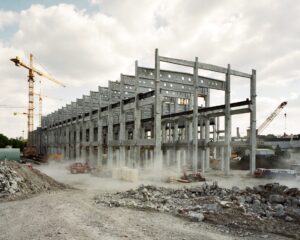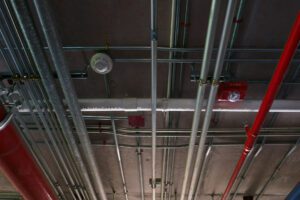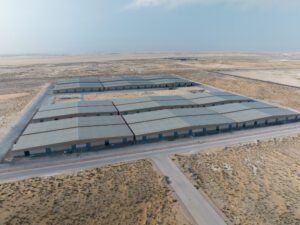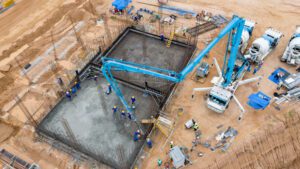Construction is known for having a significant negative influence on the environment due to the industry’s heavy reliance on resources. According to some estimates, it is responsible for as much as 40 percent of the world’s carbon emissions.
In addition to that, the industry is a major contributor to pollutants. According to the World Bank, if immediate action is not taken, the amount of garbage generated from buildings would grow by 70 percent by the year 2050.
In addition to that, it is one of the industries that use the most water. In every step of the construction process, water is an essential resource. Whether it’s for mixing the concrete, cleaning the machinery, or soaking dry surfaces, water is required.
And despite its significant reliance on it, construction is the business that is responsible for most cases of water contamination in any other industry.
Some of the most significant threats to public health on a worldwide scale are posed by polluted bodies of water including rivers, lakes, reservoirs, and oceans. We have come up with three methods that construction sites may reduce the amount of damage they do to the water supply.
Creating Safe and Sound Environments Through the Use of Non-Toxic Components
Not only do building projects that use non-toxic and non-chemical materials affect the environment less, but they also provide settings that are healthier and more enjoyable for the people who will eventually live in those spaces.
The rise of non-toxic construction materials may largely be attributed to the growing interest in environmentally responsible architecture. These may be anything from natural timber to clay plaster to straw bales and mortar, among other things.
In addition, when the building is being constructed, the site managers may decide to use environmentally friendly energy to power the heavy machines and excavators. Alternative fuels like biodiesel and vegetable oil provide less of a threat to aquatic life than fossil fuels like diesel and oil, which are among the most harmful substances that contribute to water pollution.
Taking Appropriate Measures to Dispose of the Waste and Debris Produced by Construction
At this point, there are stringent regulations in place regarding the disposal of building debris throughout the majority of developed and rising nations. In many cases, violating these restrictions may result in legal repercussions on your part.
However, even if the site managers obey these requirements, a significant amount of the garbage and debris from the building site will still wind up in industrial landfills. These landfills may include dangerous elements that put the safety of water at risk.
At every level of the building process, the site managers are required to take a comprehensive and attention-to-detail-focused approach in order to forestall the introduction of contaminants into the water supply.
The separation of waste and its transport to the right disposal sites, the prevention of chemical leakage by securing all of the chemicals, and the performance of chemically intensive work at a distance from bodies of water are all examples of the measures that should be taken.
Education of Site Managers Regarding the Prevention and Control of Soil Erosion
The uppermost layer of the soil has the greatest degree of biological activity and holds the majority of the organic matter as well as the nutrients that the plants need. This layer often performs the function of a natural filter.
It assists in controlling the flow of water, warding off pests and illnesses, and maintaining the fertility of the ground. However, some stages of building, such as drilling and filling, significantly degrade the quality of the soil.
These processes include: Erosion of the soil brought on by building operations may lead to the contamination of rock and sediment sources if these locations are not safeguarded. Whenever they make their way into natural water sources and streams, they have the potential to damage such resources in an irreversible manner.
There are a variety of approaches that may be used to reduce the amount of land that is disturbed and to avoid soil erosion. This is necessary due to the fact that the natural habitat and soil of each building site are distinct.
As a result, competent site managers have an obligation to study and comprehend the risks of erosion that are present at each site and to remain current with the legislation that applies in the area.
Select Materials that Do Not Harm the Environment
The selection of building materials has the ability to drastically cut down on the air and dust pollution caused by construction as well as limit the pollution caused by silt. In particular, a decrease in the usage of steel and cement would have a significant influence on emission rates.
This is due to the fact that minerals included in cement are responsible for 32% of all emissions caused by the use of materials. Insulation made of bamboo, cork, sheep’s wool, and wood from sustainably managed forests are examples of suitable alternatives to conventional materials.
Reusing materials and components, in particular steel, recovered wood, and aluminum, might provide a solution that is viable over the longer run.
In the building industry, concrete, and cement are responsible for some of the highest emission rates. However, there are now “greener” options available, such as carbon-injected concrete and MOC (magnesium oxychloride cement).
These ecologically friendly alternatives are reaping the advantages of ongoing research and development, which has resulted in considerable increases in production without sacrificing either the integrity or the strength of the product.
Use Data Intelligence
Connectivity at the building site makes it simpler than ever before to make use of data intelligence to cut down on pollution caused by construction while simultaneously raising both productivity and efficiency.
Real-time updates eventually reduce the likelihood of risk and mistake, get rid of bottlenecks, and get rid of the need to go to the site often, all of which lead to a decrease in emissions. A reduction in particle emission, as well as noise pollution, and maybe even light pollution, might be achieved with the installation of sensors on machines.
The need for machinery to run when it is not being used is eliminated when it is ensured that all site machinery is optimized in terms of journey routes and improved workflow.
This results in an increase in construction efficiency, a reduction in air pollution, and lower costs, particularly when vehicle diagnostics are used in conjunction with the optimization.
Incorporate Modernized Pieces of Equipment
On-road vehicles are held to a higher level than equipment used on construction sites. The effects of the building sector will become more noticeable as the drop in air pollution caused by motorists and other road users continues.
Traditional diesel generators, which are responsible for 25% of construction site particle emissions as well as noise pollution, can be converted into hybrids by using products developed by companies such as Off Grid Energy.
These hybrids have a fuel consumption that is up to 60% lower than traditional diesel generators. Diggers and excavators that use hybrid power are also in the process of being developed, and Volvo is now testing one of these machines.
Maximize the Potential of the Current Building Usage
Analysts believe that emissions from the construction of buildings alone will grow by 37% in the coming years, and this is despite the fact that the manufacture and supply of building materials are responsible for 60% of all consumption-related emissions.
When you combine these startling figures with the decrease in traffic on high street and the necessity for office space, you have the makings of a tremendous opportunity.
By reusing buildings that have already been constructed, not only would any pollution that was produced during the construction of the building itself be eliminated, but so would any pollution that was produced during the development of the supporting infrastructure.
Due to the fact that the process of land clearing is eliminated when existing structures are reused, the amount of water pollution that is caused, particularly that which is caused by sediment and silt, is reduced.
In addition, the overall development of Brownfield sites has the potential to be more financially beneficial and favorable to the community.
Show Due Diligence
In spite of the fact that there is a wealth of opportunities to find more ecologically responsible materials and technology, it may also be useful to embrace innovative procedures.
Along with the utilization of data intelligence, which is something that all construction sites should utilize for a multitude of reasons, simple on-site changes in habit can go a long way toward the reduction of water pollution, air pollution through the minimization of dust pollution, and noise pollution.
The potential for water contamination may be reduced by preserving as much of the existing plant cover as is practicable, reducing the amount of land disturbance that occurs, and guarding and covering drains.
Simply covering objects, and then lightly spraying them with water to keep them wet, is an easy way to cut down on air pollution caused by dust.
Take Away
In addition to having disastrous effects on the environment and public health, improper management of water on construction sites may result in serious harm to a company’s legal standing, economic standing, and image.
After a problem of this kind has arisen, for example when a building site has polluted the groundwater, it may be exceedingly challenging or perhaps impossible to rectify the situation.
Over the next 80 years, the globe will need the construction of more than 2 billion structures as a direct result of the tremendous increase in urbanization and population.
Because of this, the construction industry has a greater environmental duty than it ever has before in order to keep the world’s rivers and the planet itself cleaner.














